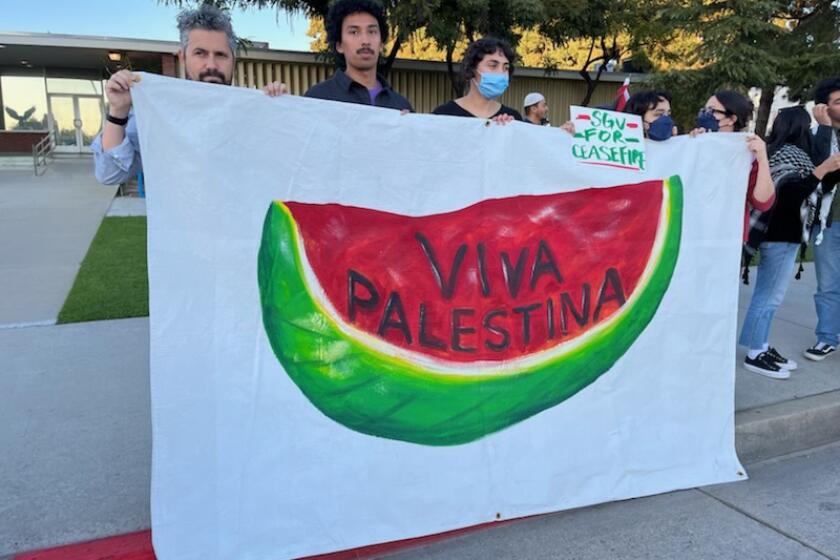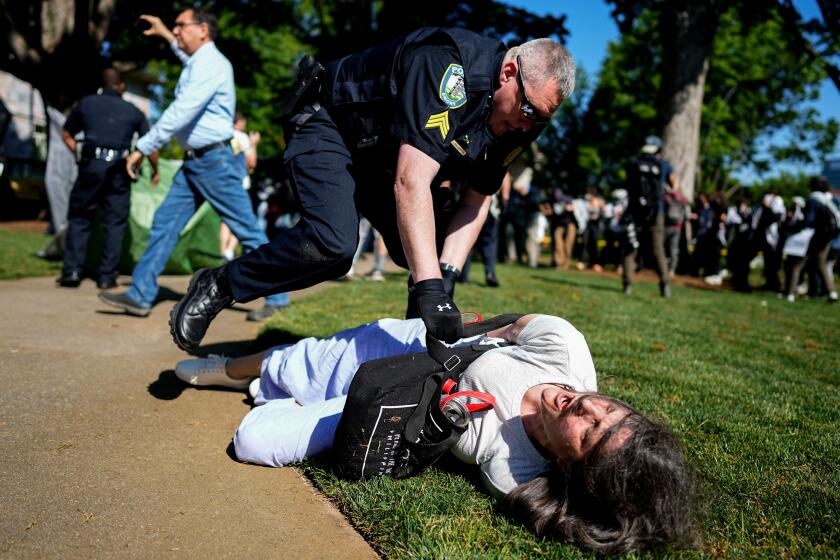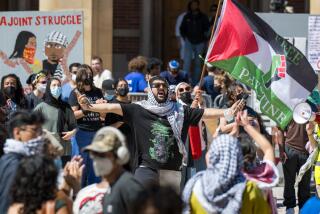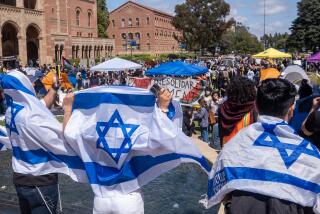Pringles, plywood and chalk: The supply chain sustaining the Cal State L.A. encampment

- Share via
Valeria Mena opened the trunk of her SUV near Zamora Park in El Monte and beamed. She had emptied it to make room for as much stuff as possible.
“This is as clean as it’s been in a while,” she joked to a group of friends.
In went board games, a five-gallon jug of water and a pack of mini-water bottles, a soccer ball and boxes of Svenhard’s Danishes and Pringles. Next up: a trip to Walmart to buy safety goggles, zip ties, blankets and fire-resistant gloves.
The final destination: a pro-Palestinian encampment at Cal State Los Angeles.
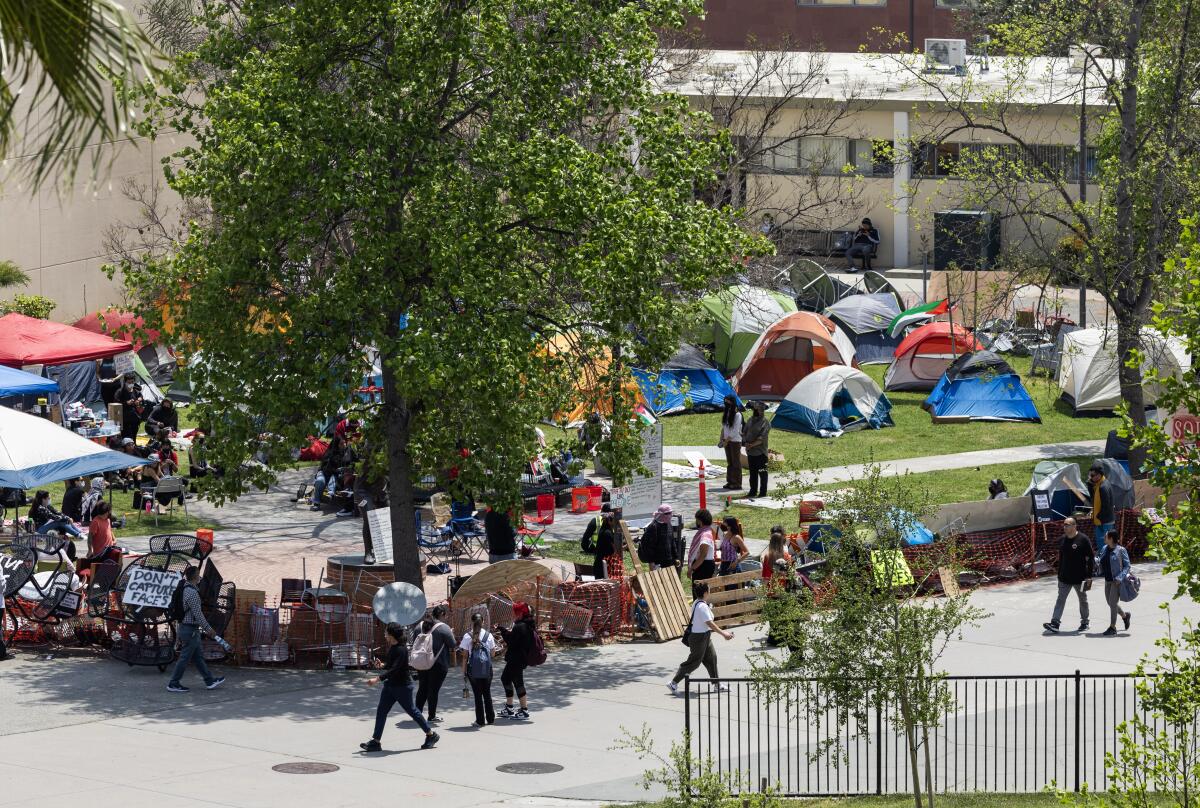
On May 1, students occupied a stretch of grass next to the school gymnasium and vowed not to leave until the university divests from all investments with Israel, boycotts organizations with ties to the country and calls for a permanent cease-fire in Gaza.
They plugged into a movement that has swept college campuses across the country. In Southern California, encampments have sprouted at UC Irvine and my alma mater, Chapman University, where I occasionally teach classes. Huge ones at UCLA (where I earned a master’s degree) and USC drew national attention after police arrested hundreds of participants while clearing them out.
The Cal State L.A. encampment hits different. It’s happening at a commuter school on the Eastside, with a blue-collar, Latino-majority student body of all ages who wouldn’t seem to have the time to protest, let alone live in a tent town for days.
Anyone surprised by what’s going on at Cal State L.A., though, isn’t paying attention.
Latinos who have never been politically active are now attending rallies expressing support for Palestinians.
The school has a tradition of activism dating back to the 1960s Chicano movement. And as I wrote in a columna last month, many young Latinos have embraced the Palestinian cause since Oct. 7, when a Hamas-led massacre of about 1,200 people prompted Israel to launch a bombing campaign that has killed more than 34,000 in Gaza, according to the Hamas-run Health Ministry.
Activists have pushed Latino-majority cities such as Bell Gardens and Cudahy to pass cease-fire resolutions, have organized bilingual rallies from Boyle Heights to Santa Ana and have lighted up social media with posts making parallels between Israel’s treatment of Palestinians and how the U.S. has treated Latin America.
“It’s a lot of youths’ first time to be in that type of setting,” Mena said. The 25-year-old is a volunteer with Casa Zamora, a community space in Zamora Park that usually holds workshops on topics such as corridos, art and local history. On Friday, it served as one of three loading zones for a Cal State L.A. supply run.
“We’re trying to provide some assurance, to let them know that faces like ours have their back,” Mena added.
“You feel the need to support community,” said Isabel Pan, a 20-year-old sophomore at Pitzer College, which has its own encampment. She couldn’t go to Cal State L.A., but her friend was one of 20 people arrested last month after students occupied the president’s office at Pomona College. “A lot of different fights are connecting, and people want to be a part of them.”
Pedro Gonzalez is a UCLA graduate who remembers walking “hundreds of times” through his alma mater’s Dickson Plaza, where the school’s pro-Palestinian encampment existed for nearly a week, attracting a violent attack from counterprotesters before being cleared by law enforcement early Thursday morning.
Seeing the cops fire flash grenades and less lethal rounds that injured protesters “was disturbing,” said the 26-year-old. “I couldn’t make it out there, but helping to gather supplies [for Cal State L.A.] is one way to support.”
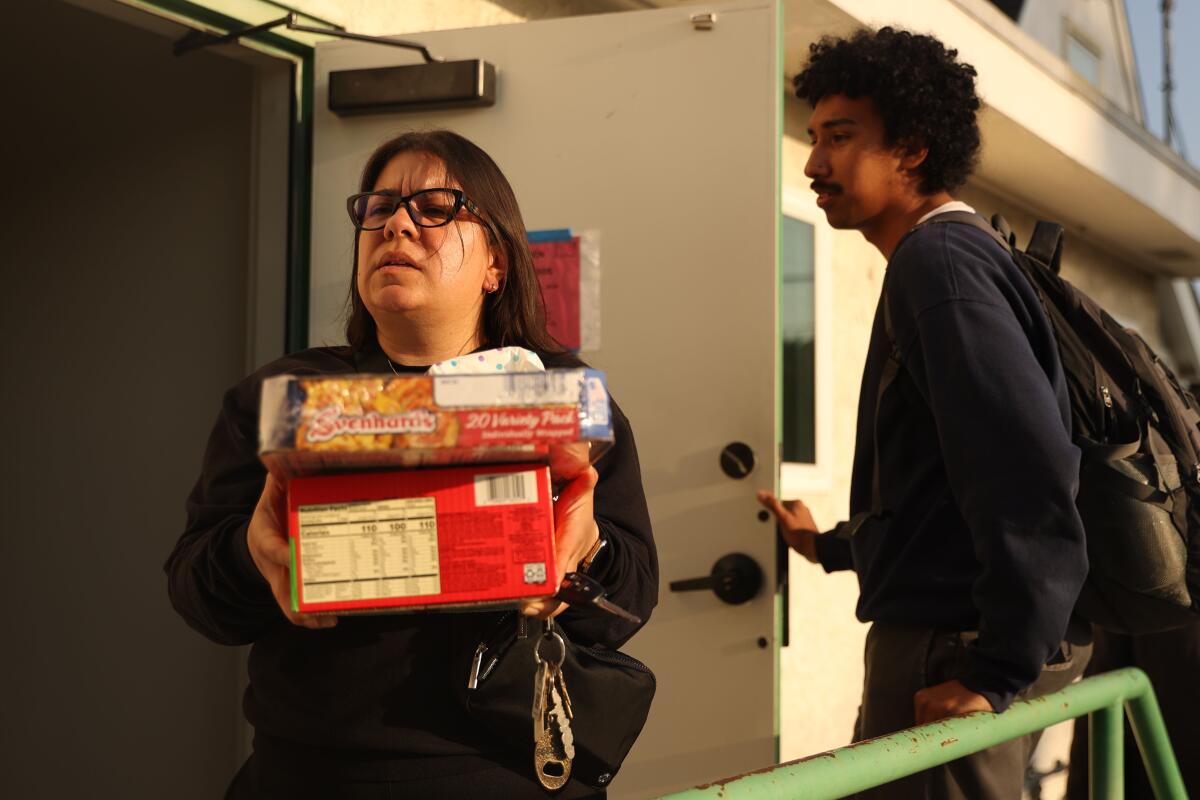
The group arrived at Cal State L.A. just after sunset. They unloaded in a small parking lot packed with others doing the same. The scene looked like the outside of a Home Depot as people carried neon-colored safety vests, sheets of plywood and planks of various lengths. Others lugged tubs stuffed with blankets, sleeping bags and first-aid kits.
Ysabel Jurado, a candidate for the City Council district that includes Cal State L.A., showed up at the invitation of students, bringing bean and cheese burritos from La Abeja in Highland Park.
“We can’t look away from the horrors in Gaza,” she said. “And these students are peacefully exercising their right to free speech and moving the needle on the conversation, and they need our support.”
In the parking lot, Zhao Feng Ye was taking a break after unloading a carrier van packed with wooden pallets.
“A lot of us adults are asking ‘What can we do?’ We’re marching, we’re calling politicians who are doing the bare minimum, and we feel helpless,” the 34-year-old San Gabriel Valley resident said. “So when we see the next generation do this — it’s not an easy task for them to risk standing up to a multibillion-dollar institution. When you see it happen at a commuter school — it’s big. It’s a powerful statement.”
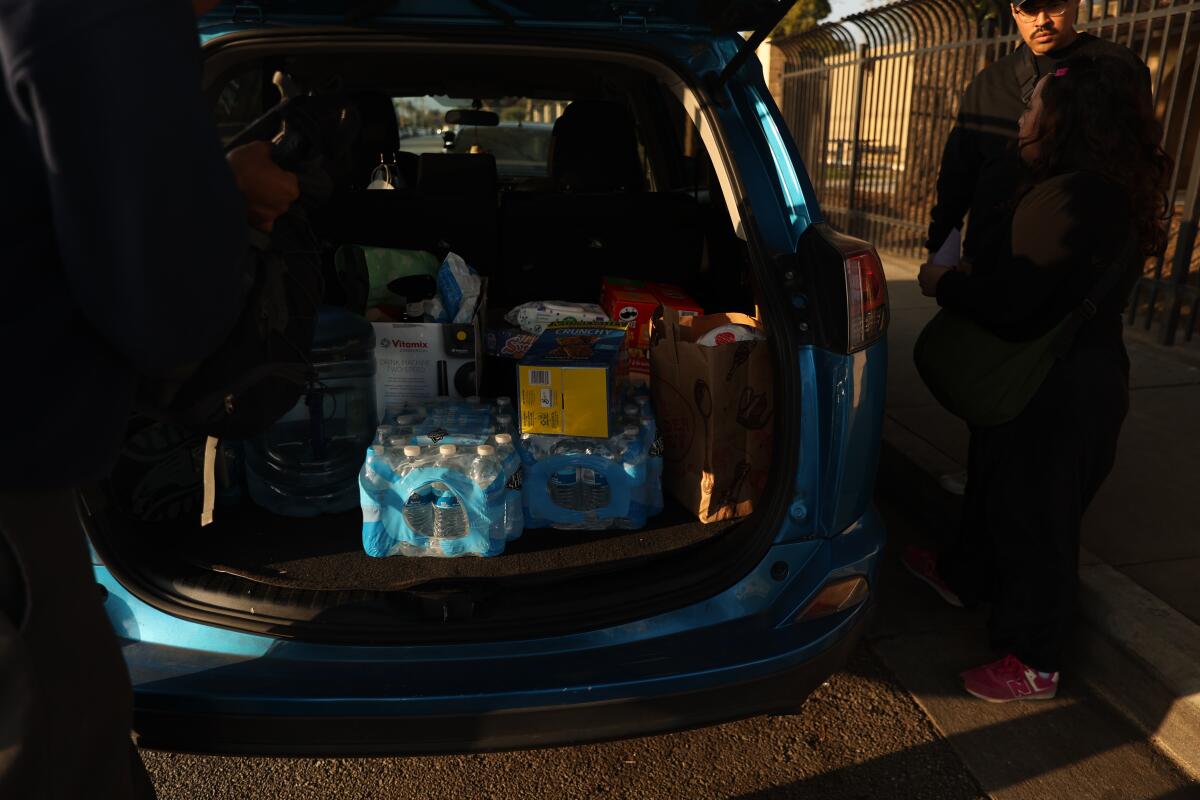
Sam Vasquez and his girlfriend, Nayellie Diaz, showed up with masks and chalk.
“They’ve come a long way from back in the day,” said Diaz, a 35-year-old alumna of Cal State L.A. In 2016, she and classmates tried to block traffic on the 10 Freeway near the campus after Donald Trump’s presidential victory. “It’s beautiful to see community members here as well.”
Vasquez, 36, participated in the Occupy movement as a student at San Francisco State. “It’s a mischaracterization that students should be in their classes,” he said. “But this is another way of doing politics.”
He looked on as more people showed up. “I can’t help out like I used to before. But I can help resupply.”
As has happened throughout U.S. history, student demonstrations over Israel’s war in Gaza are a prism of the wider world. Their activism must be taken seriously, for all our sakes.
More than 100 people mingled inside the encampment, blocked from public access by a three-layer barricade of plywood, steel safety barriers and metal picnic tables pulled from the school’s eating area. One sign proclaimed “Jesus was Palestinian”; another stated “Free Palestine” in Vietnamese. Pup tents were set up in the center; pop-up tents housing food and medic stations ringed the perimeter. Graffiti on the lower part of the gym wall contrasted with a mural at the top that commemorated its role in the 1984 Summer Olympics.
Burly men took turns manning the entrance, which consisted of half a pallet with a sign listing crossed-out numbers above the words, “And Counting.” Nearby was a Purell hand sanitizer dispenser, a statue of Billie Jean King decorated with a mask, a Palestinian flag, and a bouquet of baby’s breath and what looked liked cosmos flowers. Protesters were in their 20s and 30s and mostly Latino. Volunteers used drills to fortify the barricades, as camp lights turned on and folks began to settle for the night.
Joviality was in the air. No one in the encampment wanted to give their names — although a young woman admitted that the small boxer dog with her was named Lola.
I asked to speak to the media contact, and a skinny, jittery spokesperson who gave their name as Natalia emerged. They politely declined to let me in and asked that we speak underneath a tent just outside the encampment with a paper sign that said “Media.” Another sign warned that the protesters retained the right to refuse comment.
Natalia is a Cal State L.A. student who’s been enrolled at the school for “a while.” They said most of the other protesters were students, too.
“It fills our heart to see people helping to support us play a part in ending the genocide in Gaza,” they said.
When I asked about some people’s surprise that a commuter campus like Cal State L.A. would have an encampment, Natalia replied, “Even though we have to drive a long way, our effort in ending our complicity in ending this genocide is a lot more than having to drive to get here.”
What item had they received the most of?
“Water — it’s been hot.”
How long would the encampment stay up?
“Until we win.”
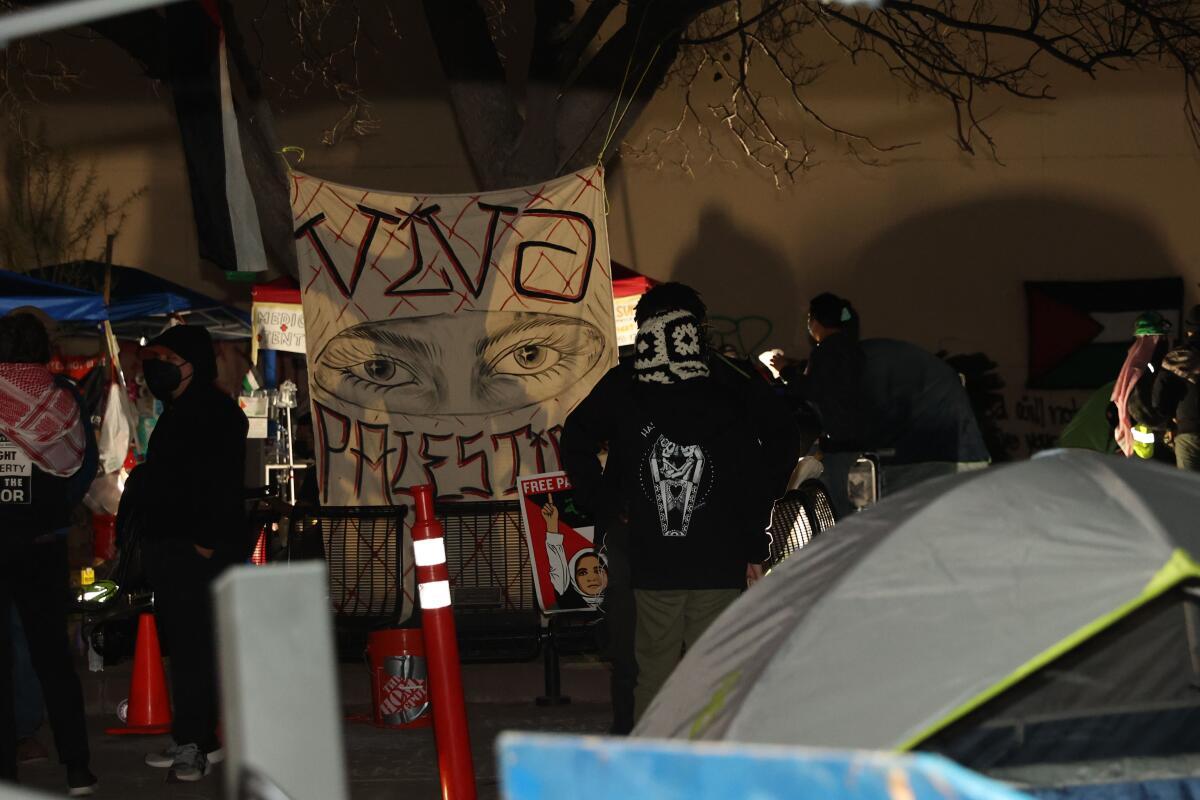
Natalia noticed a Times photographer taking photos. “Masks up!” they screamed to people inside the encampment.
I thanked Natalia and chased down passersby for comment. Most refused.
A young woman walked by, raised her fist and shouted “Free Palestine!” She gave her name as Ana and attends UC Riverside.
“I didn’t know it was going on. I’m very interested,” said the East Los Angeles native. “We have always been told you have to learn from history, or history will be repeated. I think students don’t want to repeat that.”
A young man holding a piece of white toast with beans on top had just left a study session.
“It’s nice to see people willing to fight for what they believe in,” he said, requesting to be identified as “Anonymous Student.” He said the encampment wasn’t much of a conversation topic among his classmates and offered no opinion about it since he didn’t know enough.
More people carried supplies past us as the student thought for a moment.
“To be honest, most of my time is spent studying.”
More to Read
Sign up for Essential California
The most important California stories and recommendations in your inbox every morning.
You may occasionally receive promotional content from the Los Angeles Times.
